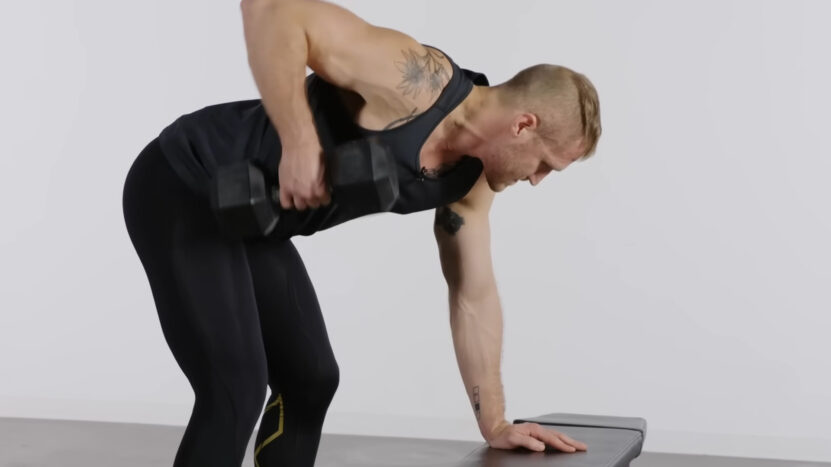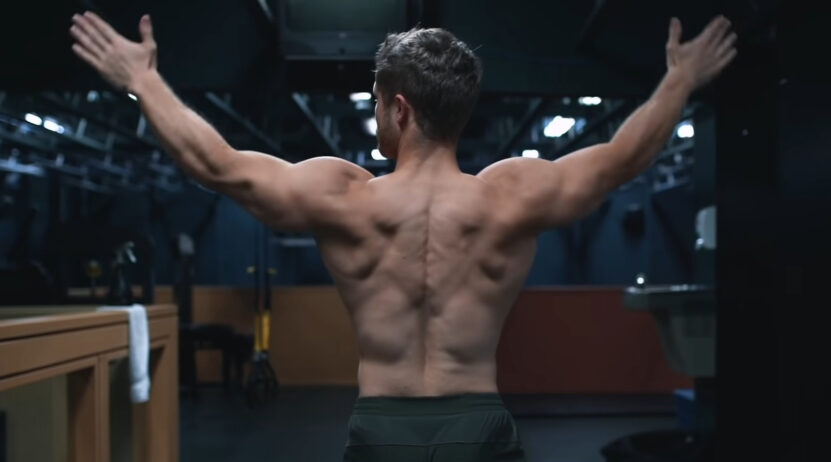Lots of trans masculine folks ask us about ways to build their back and create the illusion of smaller hips, and the answer is by developing a big, strong back. Many people (not just trans men!) from general fitness enthusiasts to professional bodybuilders are after this superhero look.
Genetics play a part, but with hard work and the right exercises, it’s attainable. Building a V-shape begins with building the lats and ends with well-developed delts.
The key is including a mix of pull-down and rowing exercises: pulling movements build width, and rowing movements add thickness. You’ll want to include tried-and-true exercises like deadlifts, pull-ups, and seated cable rows.
These Three Exercises Are a Must to Build that V-Taper
Exercise #1: Standing Lat Pull Down
Hands down, our favorite exercise to recommend is the standing lat pull-down.
- You will start by grabbing the wide bar from the top pulley of a pulldown machine and using a wider-than-shoulder-width pronated (palms down) grip. Step backward two feet or so.
- Bend your torso forward at the waist by around 30 degrees with your arms fully extended in front of you and a slight bend at the elbows. If your arms are not fully extended then you need to step a bit more backward until they are. Once your arms are fully extended and your torso is slightly bent at the waist, tighten the lats, and then you are ready to begin.
- While keeping the arms straight, pull the bar down by contracting the lats until your hands are next to the side of the thighs. Breathe out as you perform this step.
- While keeping the arms straight, go back to the starting position while breathing in.
- Repeat for the recommended amount of repetitions.
Variations: This can also be performed with a shorter shoulder-width straight bar or with a rope attachment.
Exercise #2: One Armed Dumbbell Rows

Throw in some one-armed dumbbell rows to really hit your back.
- Choose a flat bench and place a dumbbell on each side of it.
- Place the right leg on top of the end of the bench, bend your torso forward from the waist until your upper body is parallel to the floor, and place your right hand on the other end of the bench for support.
- Use the left hand to pick up the dumbbell on the floor and hold the weight while keeping your lower back straight. The palm of the hand should be facing your torso. This will be your starting position.
- Pull the resistance straight up to the side of your chest, keeping your upper arm close to your side and keeping the torso stationary. Breathe out as you perform this step. Tip: Concentrate on squeezing the back muscles once you reach the full contracted position. Also, make sure that the force is performed with the back muscles and not the arms. Finally, the upper torso should remain stationary and only the arms should move. The forearms should do no other work except for holding the dumbbell; therefore do not try to pull the dumbbell up using the forearms.
- Lower the resistance straight down to the starting position. Breathe in as you perform this step.
- Repeat the movement for the specified amount of repetitions.
- Switch sides and repeat again with the other arm.
Exercise #3: Side Lateral Raise
You’ll feel the burn throwing some side lateral raises into your routine. They are a great isolation exercise for your delts, and capping off your back with big round shoulders completes the V-look.
- Pick a couple of dumbbells and stand with a straight torso and the dumbbells by your side at arm’s length with the palms of the hand facing you. This will be your starting position.
- While maintaining the torso in a stationary position (no swinging), lift the dumbbells to your side with a slight bend on the elbow and the hands slightly tilted forward as if pouring water into a glass. Continue to go up until your arms are parallel to the floor. Exhale as you execute this movement and pause for a second at the top.
- Lower the dumbbells back down slowly to the starting position as you inhale.
- Repeat for the recommended amount of repetitions.
Variation: This exercise can also be performed sitting down.
FAQ
Can beginners start with these exercises?
Yes, beginners can start with these exercises but should use lighter weights and focus on form to avoid injury.
How often should I perform these exercises for optimal results?
Aim for 2-3 times a week, ensuring you give your muscles adequate rest in between sessions.
Do I need gym equipment to achieve the V-taper look?
While gym equipment can be beneficial, there are alternative bodyweight exercises that can also help in achieving the V-taper look.
Can I achieve the V-taper look without weights?
Yes, bodyweight exercises like pull-ups and push-ups can also contribute to the V-taper look.
How long will it take to see noticeable results?
Results vary for each individual, but with consistent training and proper nutrition, you can start seeing changes in as little as 6-8 weeks.
Final Words
Achieving the sought-after V-taper appearance goes beyond mere aesthetics; it symbolizes your dedication, persistence, and understanding of your body, regardless of identifying as cisgender or transgender. With the appropriate exercises, steadfastness, and drive, you can mold a back that not only appears robust but also elevates your entire physique.
Always remember, it’s not solely about the weight you lift, but the technique you employ. Prioritize form, remain dedicated, and the outcomes will materialize.

